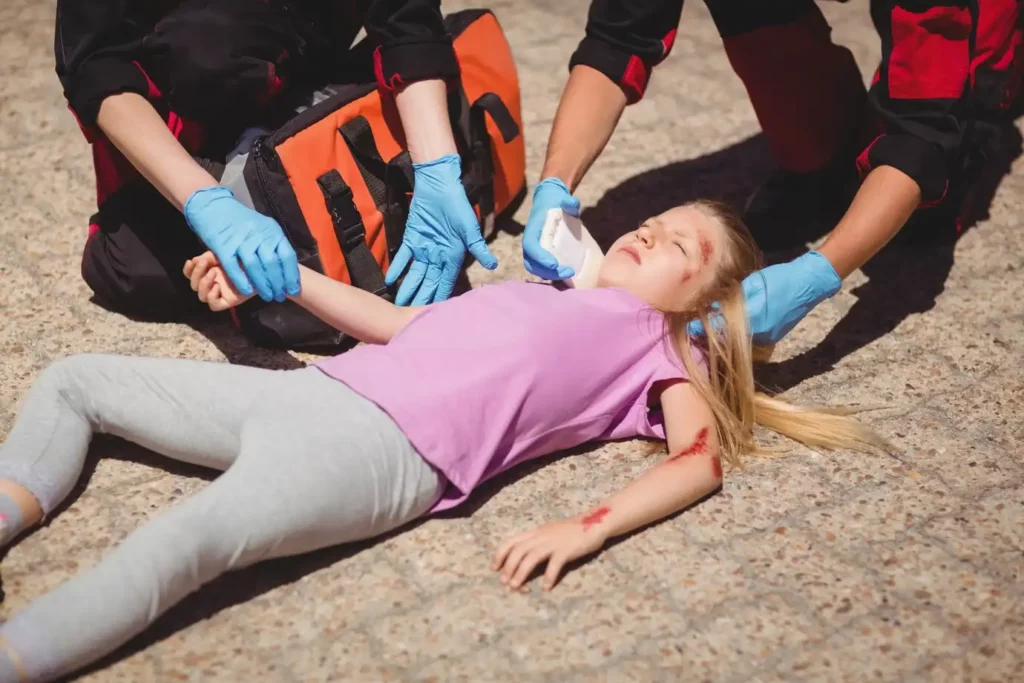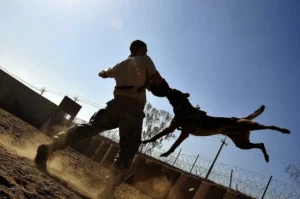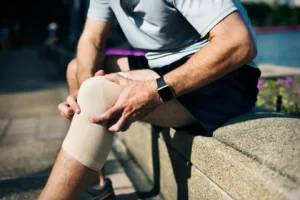Common Types of Childhood Injuries
1. Falls
Falls are the leading cause of childhood injuries, often occurring at home, playgrounds, or schools.
Examples:
- Falling from furniture or stairs
- Playground equipment mishaps
- Slipping on wet surfaces
2. Burns
Burns can result from hot liquids, stoves, or electrical outlets.
Examples:
- Scalds from hot water or steam
- Contact with hot surfaces
- Sunburns
3. Cuts and Scrapes
Minor injuries from sharp objects or rough surfaces are common as kids play and explore.
Examples:
- Cuts from broken glass or tools
- Scrapes from falling on pavement
4. Choking and Suffocation
Young children are at higher risk due to small objects or improper sleep environments.
Examples:
- Swallowing small toys or food pieces
- Suffocation from blankets or stuffed animals in cribs
5. Sports Injuries
Injuries often occur during organized sports or recreational activities.
Examples:
- Sprains and strains
- Concussions from contact sports
6. Poisoning
Curious children may ingest harmful substances if safety measures are not in place.
Examples:
- Household cleaners
- Medications
- Plants
Safety Tips for Preventing Childhood Injuries
1. Create a Safe Home Environment
- Install Safety Gates: Use gates to block stairways and dangerous areas.
- Anchor Furniture: Secure heavy furniture to the wall to prevent tipping.
- Cover Electrical Outlets: Use outlet covers to prevent electrical shocks.
- Store Hazardous Materials Safely: Keep chemicals, medications, and sharp objects out of reach.
2. Supervise Outdoor Play
- Check playground equipment for stability and safety.
- Teach children to use slides and swings properly.
- Ensure they wear helmets when cycling or skating.
3. Prevent Choking and Suffocation
- Avoid giving young children small, hard-to-swallow foods like nuts or grapes.
- Ensure toys are age-appropriate and free from small detachable parts.
- Place infants on their backs to sleep in a crib free from pillows and blankets.
4. Practice Fire Safety
- Keep matches, lighters, and candles out of reach.
- Teach children to stop, drop, and roll in case of a fire.
- Set water heater temperatures to a safe level (below 120°F or 48°C).
5. Ensure Water Safety
- Never leave children unsupervised around water, including bathtubs, pools, or buckets.
- Teach them basic swimming skills and water safety rules.
6. Educate About Road Safety
- Use appropriate car seats and seat belts for your child’s age and size.
- Teach children to look both ways before crossing streets.
- Encourage the use of reflective clothing or accessories when walking or cycling at night.
7. Prevent Sports Injuries
- Ensure children wear the right protective gear for their sport, such as helmets, knee pads, or mouthguards.
- Emphasize the importance of warming up and following the rules of the game.
First Aid Tips for Common Childhood Injuries
- Cuts and Scrapes: Clean the wound with soap and water, apply an antiseptic, and cover with a bandage.
- Burns: Run cool (not cold) water over the burn for several minutes and cover it with a clean, dry cloth.
- Falls: Apply ice packs to reduce swelling and monitor for signs of concussion, such as drowsiness or vomiting.
- Choking: If a child is choking, perform the Heimlich maneuver or seek emergency medical help immediately.
When to Seek Medical Attention
While many injuries can be treated at home, seek professional care if:
- The injury involves heavy bleeding or deep wounds.
- The child shows signs of a concussion, such as confusion or loss of consciousness.
- Burns are large, blistered, or deep.
- The child has difficulty breathing or persistent pain.
The Role of Education in Injury Prevention
Teaching children about safety can empower them to make better decisions. Use age-appropriate language to explain potential dangers and encourage safe behavior at home, school, and during play.
Conclusion
While it’s impossible to prevent every scrape and bruise, taking proactive safety measures can significantly reduce the risk of serious injuries. By creating a safe environment, supervising activities, and teaching your children about safety, you can protect their well-being while allowing them the freedom to explore and grow.
For more parenting tips and injury prevention resources, visit Injuries Wiki—your trusted partner in keeping your family safe.









